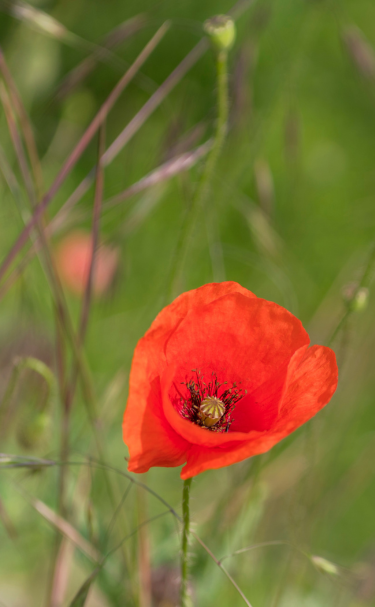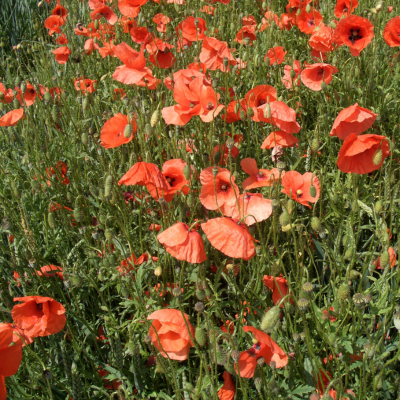The common poppy is a broad-leaved weed that can be problematic in cereals and winter oilseed rape, competing for nutrients and impacting yield.
Poppy

What is a poppy?
The common poppy (Papaver rhoeas), with its red flowers is a common sight in cereals and oilseed rape crops throughout lowland Britain. An annual plant, it germinates in both the autumn. Poppy seeds exhibit very long persistence within the soil and readily germinate on freshly cultivated land.
Due to its germination pattern, poppies are problematic in both autumn and spring sown crops. Poppy seed are frequently included in wild flower or biodiversity seed mixes, as they provide a ready feed source for pollinators.

Biology
Usually grow between 20-80 cm in height, with a large flower and large black spot at the centre.
Approximately 20,000 seeds produced per plant.
The stems are bristly and sometimes spreading with hairy upright stems (that bleed white sap when broken).
Widely distributed across the UK, favouring lowland areas, preferring moist soils and bare ground.
The large flowers have four petals are large and red/orangey with a large black spot at the centre.
Dull green leaves at the base form a rosette with divided segments.
How can I identify poppy weeds?

Fully formed
 Cotyledon stage
Cotyledon stage

Closer look at flowers
Why are poppies a problem?
Poppy is competitive in oilseed rape and wheat, and a population of only 12 plants per meter square can reduce yields by up to 5% in winter wheat. It can also be problematic in spring crops too.
Poppy seed can last up to 100 years with a germination depth of 0.5cm. With each plant producing around 20,000 seeds.
Poppies are found throughout Central, Southern and Eastern England. Resistant populations have been confirmed in mainly the east of England, with these populations being resistant to Sulphonyl urea (SU) chemistry. Studies of the UK populations confirming their resistance is conferred by the ALS target site mutations Pro-197-Leu and Pro-197-His.
Where resistance is confirmed, these populations can no longer be controlled by the SU herbicides metsulfuron-methyl and tribenuron-methyl.
To control resistant poppy populations, programmes must now include pendimethalin, MCPA and the herbicides containing Arylex™ active e.g., Zypar® and Pixxaro® EC.
How can poppies impact yield?
Poppy can be found at high plant densities and utilise resources (moisture, nutrients and light) that are not available to crops. Mature poppy are robust plants that can out compete cereal crops resulted in a marked reduction in yield. The stems of mature poppy plants are very coarse and can cause problems at harvesting.
Why is identifying poppies important?
As there are SU resistant populations of poppy it is important to know what bio-type there may be in the field. Organisations offer seed testing to confirm resistance.
Why do poppies spread quickly?
Producing large numbers of seed per plant, high persistence in the soil and a flexible germinating in the autumn and spring, poppy plants are ideally suited to infesting cropped fields.
How do I control poppies?
The best way to control poppies is to stimulate germination through cultivation before spraying with an appropriate herbicide. ALS-resistant poppies can be controlled at pre-emergence using pendimethalin, whereas the most effective post-emergences are: Zypar, Pixxaro EC or MCPA herbicides when treating cereals.
Resistant poppy seeds are likely to persist in the soil for many years so it is unlikely that sulfonylureas will be an effective treatment for control of poppy affected fields again.
Regularly herbicide resistance tests on seeds or plants, provide a strong indication of the profiles present across each field. To do so, collect the poppy seeds when the seedpods become a greyish-brown colour (July/August) and cut the seedpods from the stem, placing in a paper bag or envelope. Leave the seeds in a well-ventilated area keeping the bag open to.
Zypar Herbicide
Zypar® is a herbicide for the control of broad-leaved weeds in winter cereals (wheat, durum wheat, spelt, barley, rye, triticale, oats) and spring cereals.
Pixxaro EC Herbicide
Pixxaro® EC is a herbicide for the control of broad-leaved weeds in winter and spring cereals, based on innovative chemistry.